Pour Decision #11: Mastering Fresh Mozzarella and Burrata with Grandma
Tapping into our Italian roots at The Cook’s Studio in Patchogue
My grandma’s 75th birthday recently passed, and I wanted to give her something that she would remember forever. After a few minutes of scrolling through lists of ‘Best Gifts for Grandmas’ online, a light bulb went off in my head. If there is one thing my grandma and I have in common, it is that we both love to cook. In fact, my grandma is one of the best cooks that I know. So, I booked us a class at The Cook’s Studio in Patchogue, where we learned to make fresh mozzarella, silky burrata cheese, garlicky Castelvetrano olive pesto and zesty tomato salad.
When we arrived at the studio, a rush of dopamine flooded my system. The air oozed hospitality, and offered the feeling of a sanctuary I never wanted to leave—I was completely in my element. Grandma and I were seated at our table, ready to learn, cook, taste deliciously fresh food, and laugh for the next two hours. The class kicked off with an exceptional demonstration by Executive Chef Stefanie, a graduate of the French Culinary Institute in Manhattan. Her sense of humor, ability to communicate with the class, and knack for teaching a rather challenging lesson at lightning speed was admirable.
A camera hovered over Chef Stefanie’s workstation, providing us with a bird’s-eye view of her demonstration on the ‘Jumbotron’ in the studio (just a rather large TV). The precision of her knife skills and the way she kept her neat workstation throughout each step of the process was inspiring, especially considering my inability to stay tidy when I cook at home (sorry, Mom).
After a quick thirty-minute lesson, we dove right into action, starting with toasting crostini. Yes, they have gluten free options! At the studio, we used induction cooktops, where the heat is generated through electromagnetic energy. “They go from zero to hot way too quickly,” Chef Stefanie noted during her demonstration. These cooktops heat faster than your traditional electric or gas ones, so there’s no need to preheat the pan. We learned that when toasting crostini, you only toast one side, or “you’ll go from crostini to crouton,” Chef Stefanie quipped. When cutting bread for crostini, you should only slice it in the direction that creates the smallest pieces, as a crostini isn’t meant to be the size of sandwich bread.
We powered up the induction stovetop, doused the crostini in organic extra virgin olive oil, which has a higher smoke point; the temperature at which the oil begins to break down and produce visible smoke. As Chef Rachael Ray would say, ‘EVOO’ can withstand higher temperatures without burning, ensuring the crostini turn golden brown without becoming bitter or burnt. We placed the bread oil side down and let it toast for 4-5 minutes. While the bread was toasting, we started making the fresh tomato salad, which would be plated atop our toasts and paired perfectly with the fresh cheese. The salad consisted of diced cherry tomatoes, cucumber, shallots, chopped garlic, and fresh parsley. When cooking with parsley, pull the leaves off the stem, as the stem offers a bitter flavor. Fun fact: parsley paired with raw garlic supposedly helps chill garlic breath, which is why parsley became a staple in many Italian dishes. I can personally attest that the parsley did not help me in that regard, but it was delectable nonetheless.
When making the salad, we learned the proper way to hold our chef’s knives, which should only be used to precisely cut vegetables. Some words of advice: use the tip of the knife to dice the tomatoes, and slide the garlic to the edge of the cutting board with the handle of the knife hanging off to properly smash it. After all the ingredients were mixed in a bowl, we finished it off with freshly cracked salt and pepper to taste, EVOO, and vinegar. The salad was then set aside to marinate in the oil and vinegar, allowing the tomatoes and cucumbers to soak up the salt, which helps the vegetables to release water and dilute the salinity.
Next, we made Castelvetrano olive pesto the prehistoric way, using a stone pestle and mortar. We hand-pulverized and ground cashews and garlic, followed by the olives in batches to achieve the perfect consistency. Since the olives are already salty enough, it is recommended to skip the salt, but definitely go heavy on the cracked pepper, with a TON of Parmesan cheese and olive oil, until the pesto reaches your ideal texture. I loved this pesto, more than your everyday basil pesto and will definitely be making it at home!
Now for the main event: the fresh mozzarella and burrata—the stars of the show. We began by breaking apart three pounds of fresh mozzarella cheese curd, while waiting for the water to boil until it had ‘big fat bubbles.’ Once the curd was broken apart and the water was roaring, we added a generous amount of Maldon flake sea salt (from Essex, England), poured the hot water over the curd, and scraped a wooden spoon along the bottom of the bowl. After about 3 minutes, using your wooden spoon, pull the cheese to one side of the bowl, and then prepare to manipulate it—though it is important not to overdo this step or the cheese won’t come out silky and luscious. We were instructed to do three cheese pulls with the wooden spoon to stretch out the cheese in preparation for shaping it.
After doubling up on gloves, we were instructed to dip our hands into the near-boiling water. But have no fear, the cheese curd absorbs the heat of the water, leaving it at around 160 degrees, which is safe. The next step is to dip your hands in, pinch off a bit of the cheese to your preferred size for the cheese ball, then toss it back and forth like a hot potato! You pull and fold it over twice, then turn the cheese under itself to form a ball. It is not recommended that you squeeze the cheese or pack it like a snowball. Handle your cheese with care for the best result! If air bubbles appear in your cheese, dip it back into the hot water and gently massage them out, then wrap your cheese in plastic wrap and set it in cool water so it holds its shape.
Did you know that burrata cheese is not injected? And it almost directly translates to ‘stuffed mozzarella cheese.’ Making burrata is simple. You start the same way as mozzarella by ripping off your desired size, but then you flatten it out like a pancake in the palm of your hand. From there, you add ricotta cheese in the center, enclose the ricotta within the mozzarella, and rip the excess mozzarella off the top before shaping it. Be careful not to squeeze too tightly, or it will pop! Just like mozzarella, place the burrata into cool water to hold its shape.
At the end of the class, we were allowed to get creative and plate our own dishes. Chef Stefanie says that chefs always eat with their eyes first, and if you think about your restaurant experiences, they tend to plate in threes because it just looks better. I didn’t follow the three-toast rule with my dish because I’m no chef, and ended up eating about nine pieces of crostini instead of three… I smeared pesto across the plate, dolloped tomato salad in one corner, and arranged four crostinis in an arch around the pesto. Voila! We were finally able to cut the cheese (literally!), using the serrated knife (not the chef’s knife), and taste the silky freshness. Grandma loved it so much, and you could tell by her reaction after her first taste. Our dishes were drizzled with balsamic glaze, or as Chef Stefanie called it, ‘salad candy,’ and the rest is history. We devoured our ‘linner’ (lunch + dinner) and even took home five fresh mozzarella balls, which just so happen to be one of my dad’s favorite cheeses, next to stinky provolone.
I had so much fun, and so did my grandma. It was a lovely way to spend time together and create memories neither of us will forget. The two hours flew by, and you know what they say—time flies when you’re having fun. I can’t say this was a pour decision by any means. Having two glasses of wine, however, might have been. Still, it was one of the best decisions I’ve made, and I’d spend any amount of money to have quality time with my grandma like this again!
Tapping into our ‘Italian roots’ was especially exciting. My grandma is Danish, but she learned to cook Italian recipes because, well, her husband, my grandpa Tony DiMasso, is Italian, so that makes her an honorary Italian after 50+ years of marriage. And, of course, his favorite dish is chicken Parmesan, because us Italian Americans can’t resist the classics!
A big thank you to The Cook’s Studio, Chef Stefanie, and Kim for such an enriching experience. I know for a fact that I’ll be back, and I highly recommend you go too! Just a heads-up, the mozzarella and burrata class has been the most sold-out class since 2019, so there might be a wait. If patience isn’t your strong suit (like me), don’t worry—there’s a range of classes to choose from, including but not limited to paella, fresh pasta primavera, surf and turf, and sushi. Channel your inner chef and have a great time with even better food (and don’t fret, beverages are available upon request)!
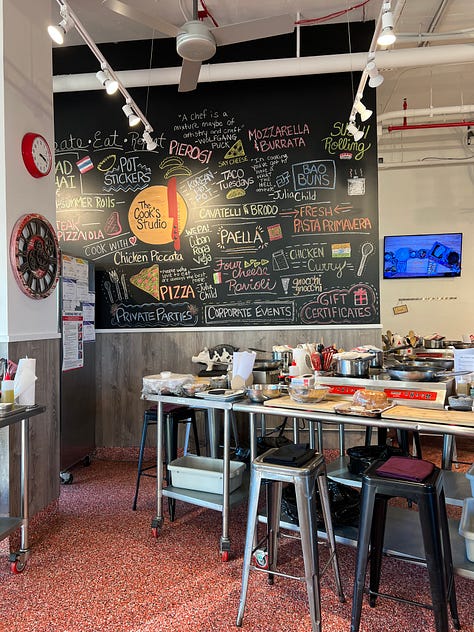


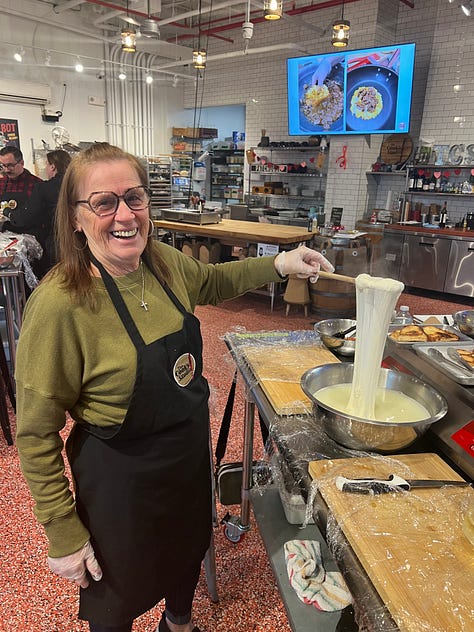
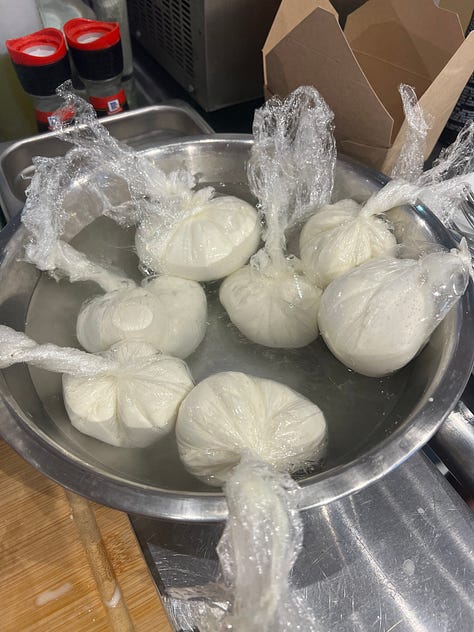
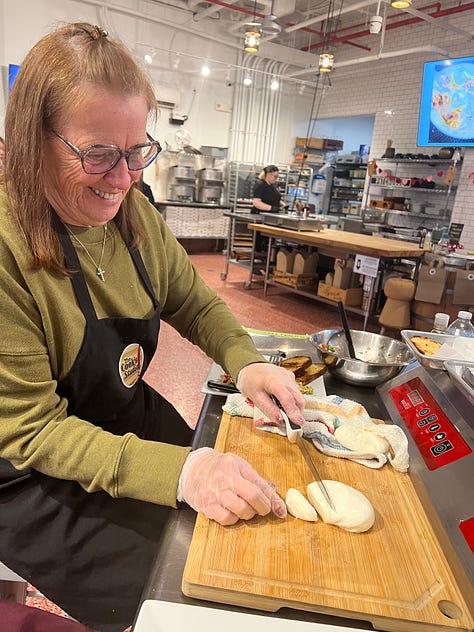

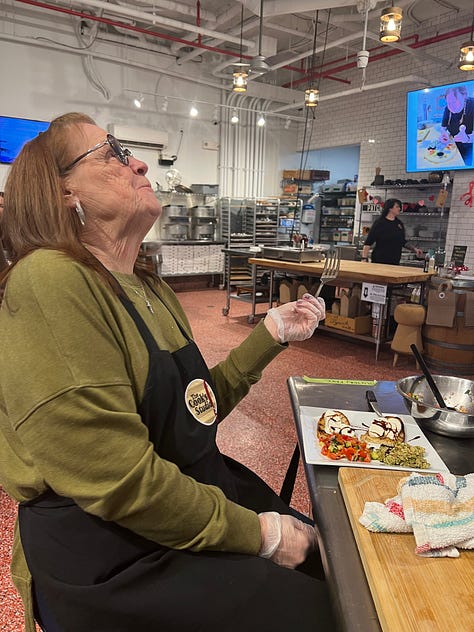
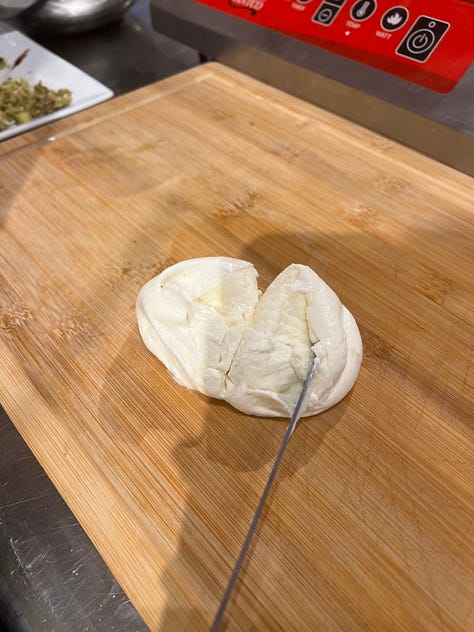




Nice writing,
Seems like such a great time! So nice to know they are also accommodating for those with food allergies! Definitely have to check it out myself:)